Za’atar: The Middle Eastern Spice That Delights the Senses

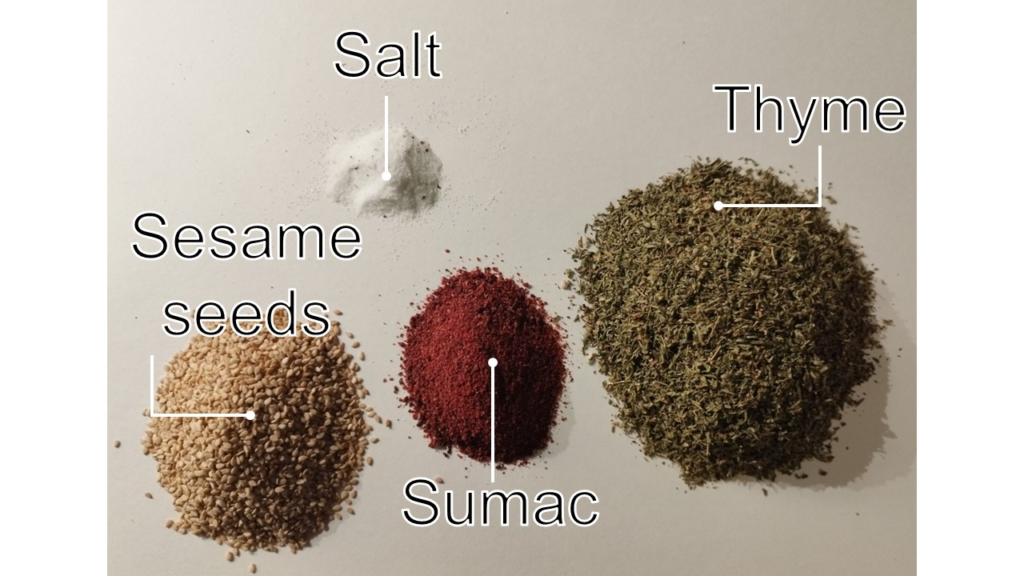
Za’atar (also spelled Zaatar or Zatar) is one of the most common middle east spice mixtures. It is made from dried spices and herbs which make it a very versatile seasoning for bread, hummus, meat and other types of seasoning. Za’atar is the common name of the herb, a wild thyme (Origanum syriacum), which is native to the middle east (countries including, Lebanon, Syria, Palestine, Israel, Jordan and parts of Turkey and Cyprus) and the main ingredient of Za’atar mix. It is also referred as Syrian or Lebanese oregano. The plant itself is an evergreen upright plant with small velvety leaves and white or pink flower-like petals. Grows in rocky, fully sunbathed regions where there is a well-drained soil. The wild thyme is harvested in the summer when it is dried and stored. The taste of the wild thyme can be described as earthy, minty with lemony notes, while the aroma is herbal and lemony (8-11).
There are some variations that you can find from country to country, but the core ingredients of the mix are the following:
1. Thyme (Origanum syriacum): The primary herb, known for its earthy and slightly minty flavour.
2. Sumac (Rhus coriaria): Adds a tangy, lemony flavour.
3. Toasted sesame seeds (Sesamum indicum): Gives a nutty richness.
4. Salt (NaCl): Enhances and balances the Flavors.
Other variations of the spice mix will include also cumin seeds, dried oregano, dried majorana, ground coriander, ground fennel, ground anise and ground cinnamon (8-10).
Dishes Where Za‘atar spice mix Is Essential
• “Man’oosheh” (Manakeesh): A Levantine flatbread, usually round, topped with a mixture of za’atar and olive oil before baking.
• Labneh with Za‘atar: Labneh (strained yogurt generally from cow milk) with a drizzle of olive oil and topped with generous amount of za’atar. A staple breakfast or mezze item across Lebanon, Palestine, and Jordan.
• Dips and Spreads: Za’atar combined with olive oil that can be used as dip or spread
Dishes Where Za‘atar spice mix can be used
• Roasted or Grilled Vegetables: Vegetables like eggplant, zucchini, or carrots tossed with olive oil and za’atar before roasting or grilling. • Meat and Chicken Marinades: Za’atar mixed with olive oil, lemon juice, or yogurt to marinate chicken, lamb, or beef before grilling or roasting.
Variation and use of substitutes:
If you cannot get your hands on wild thyme (Origanum syriacum), you can substitute it for (1) common thyme (Thymus vulgare). Common thyme (Thymus vulgaris) can work as a base. It has a similar herbaceous and slightly minty profile but is usually sharper and less earthy than wild thyme. If you use only common thyme, the blend will still taste “za’atar-like,”.
Use mix of Herbs
Because the herb Za’atar (Origanum syriacum) has flavour notes that overlap with thyme, oregano, and marjoram, you can combine herbs to mimic it:
(2) Common thyme (Thymus vulgare) + oregano (Origanum vulgare) → gives more of the earthy, resinous notes.
(3) Thyme + marjoram (Origanum majorana) → adds a softer, sweeter layer.
(4) Thyme (Thymus vulgare) + oregano (Origanum vulgare) + marjoram (Origanum majorana) (equal parts) → closest substitute for wild thyme (Origanum syriacum).
Buying & Storing
• Purchase of thyme: dried with whole leaves if available. The thyme should be green to gray and not brownish (indicator of oxidation and aroma loss). If possible, rub some leaves between your fingers- fresh dried thyme should have strong, minty and herbal scent.
• Purchase of sumac: whole berries if available—dried berries keep longer and retain more flavour than the powdered form.
• Purchase of sesame seeds: preferably buy unhulled (whole) sesame seeds they will have its outer bran layer, giving a slightly bitter, nuttier flavour + more fiber, calcium, and lignans (sesamin and sesamolin). Smell them if possible. They should nutty, slightly sweet and not rancid or oily (oxidation of the natural oils).
.
• Availability of those spices: try searching for it at Middle Eastern markets, specialty food stores, better grocery stores, or online. In my case I was unable to purchase the real stuff (Origanum syriacum).
Storage:
• Store the mix in an airtight container in a cool, dark, dry place, away from heat and moisture.
• Shelf life: The Za’atar spice mix will keep for a few months if you keep the storage conditions as mentions above.
I will try all the variations and will give you feedback:
For Version (v) 1 recipe:
Total: 75g (2.65 oz):
35g (1.2 oz) sesame seeds
15g (0.52 oz) ground sumac
20g (0.7 oz) dried thyme (I will use common thyme, but if you have the Lebanese/ Syrian thyme use it instead)
5g (0.17oz) salt
Step-by-Step Method
The process is simple and takes only about ten minutes. Measure your ingredients. Toast the sesame seeds until brown. Combine the thyme, sumac, salt and 1/3 of the sesame seeds and blend in a kitchen robot or in a pestle and mortar. Add the rest of the sesame seed and enjoy.
Science behind the recipe
Chemistry of Za’atar’s Core Ingredients
• Wild thyme (Origanum syriacum) contains thymol, γ–terpinene, carvacrol, and α-pinene as main compounds. Those compounds contribute to the earthy and minty scent of the thyme.
• Sumac (Rhus coriaria) main compounds are gallotannins, malic acid, β-caryophyllene, cembrene, caryophyllene oxide and anthocyanin pigments which are responsible for the bright red colour and the typical flavour profile – lemony, acid, woody, and spicy.
• Sesame seeds (Sesamum indicum) containsesamin, sesamolin, tocopherols (forms of vitamin E), phytosterols.
• Salt (NaCl) Work in synergy with the flavour compounds and enchases them. It also acts as a preservative.
Biological Activities
The major constituents of Za’atar such as wild thyme (Origanum syriacum), sumac (Rhus coriaria), and sesame seeds (Sesamum indicum) have been reported to have many different biological activities. These include antioxidant, antimicrobial, antifungal, antiviral, anti-inflammatory, antifibrogenic, antimalarial, antimutagenic, antithrombin, antitumorigenic, cytotoxic, bronchodilator, hypoglycemic, and leukopenic activity (1-7).
Ingredients
Method
- Weigh out sesame seeds, thyme, sumac, and salt.
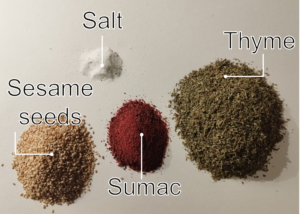
- Toast the sesame seeds. Place the sesame seeds in a cold, dry skillet over medium heat. Stir frequently until they turn golden brown and release their aroma. Remove from heat and let them cool completely.
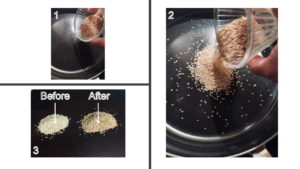
- Take ⅓ of the toasted sesame seeds and place them in a kitchen robot (food processor) or pestle and mortar. Add all the dried thyme, ground sumac, and salt. Blend or grind until powdered (around 5 min).
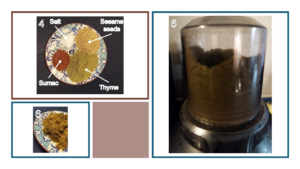
- Add the remaining ⅔ of the sesame seeds. Mix them well in order to distribute evenly in the spice mixture.
- Your Za’atar spice mix is ready! Store in an airtight container in a cool, dark, dry place. Use on bread, labneh, roasted vegetables, or meats.
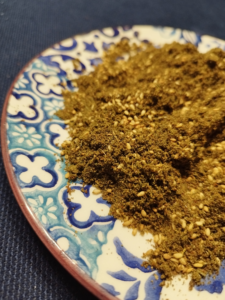
References:
1. Marchese, A., Orhan, I.E., Daglia, M., Barbieri, R., Di Lorenzo, A., Nabavi, S.F., … & Nabavi, S.M. (2016). Antibacterial and antifungal activities of thymol: A brief review of the literature. Food Chemistry, 210, 402–414. https://doi.org/10.1016/j.foodchem.2016.04.122
2. Namiki, M. (2007). Nutraceutical functions of sesame: A review. Critical Reviews in Food Science and Nutrition, 47(7), 651–673. https://doi.org/10.1080/10408390600919114
3. Lambert, R.J.W., Skandamis, P.N., Coote, P.J., & Nychas, G.J.E. (2001). A study of the minimum inhibitory concentration and mode of action of oregano essential oil, thymol and carvacrol. Journal of Applied Microbiology, 91(3), 453–462. https://doi.org/10.1046/j.1365-2672.2001.01428.x
4. Peter, K. V. (Ed.). (2012). Handbook of herbs and spices: Vol. 2 (2nd ed.). Woodhead Publishing. https://doi.org/10.1533/9780857095688
5. Abachi, S., Macé, S., Lee, S., & Rupasinghe, H. P. V. (2022). Cranberry and sumac extracts exhibit antibacterial and anti-adhesive effects against Streptococcus pyogenes. Journal of Medicinal Food, 25(3), 235–242. https://doi.org/10.1089/jmf.2021.0047
6. Martinelli, G., Angarano, M., Piazza, S., Fumagalli, M., Magnavacca, A., Pozzoli, C., Khalilpour, S., Dell’Agli, M., & Sangiovanni, E. (2022). The nutraceutical properties of sumac (Rhus coriaria L.) against gastritis: Antibacterial and anti-inflammatory activities in gastric epithelial cells infected with H. pylori. Nutrients, 14(9), 1757. https://doi.org/10.3390/nu14091757
7. Rayne, S., & Mazza, G. (2007). Biological activities of extracts from sumac (Rhus spp.): A review. Plant Foods for Human Nutrition, 62(4), 165–175. https://doi.org/10.1007/s11130-007-0058-4
8. Norman, J. (2015). Herbs & spices: Over 200 herbs and spices, with recipes for marinades, spice rubs, oils, and more. DK Publishing
9. Lakshmi, P. (2016). The encyclopedia of spices & herbs: An essential guide to the flavors of the world (J. Sutton & Kalustyan’s, Eds.). HarperCollins.
10. Farrimond, S. (2018). The Science of Spice: Understand flavour connections and revolutionize your cooking. Dorling Kindersley Ltd.
11. Origanum syriacum – Plant Finder
